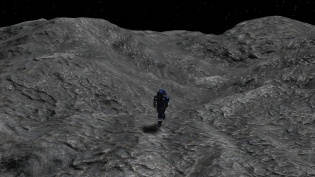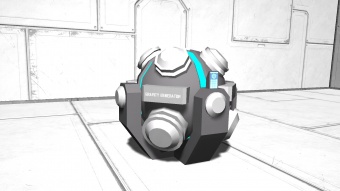Difference between revisions of "Spherical Gravity Generator"
(+added default range info updating power requirements.) |
m (+fixed error in example.) |
||
| Line 67: | Line 67: | ||
Therefore a generator set to a radius of 200 m at full strength should require: | Therefore a generator set to a radius of 200 m at full strength should require: | ||
| − | ( | + | (18,840,000 / 2,355,000) x 0.7 x 1 = 5.60 MW |
=== Mechanics === | === Mechanics === | ||
Revision as of 18:07, 3 December 2015
Contents
Function
Operating the same way as a Gravity Generator in which it pushes/pulls small objects, and players towards a specific direction. However, the spherical gravity generator differs in that it pulls or pushes objects in a sphere-like radius around itself.
| Control Interface Menu | |
|---|---|
| Options | Comments |
| Toggle block | Turns the device on, or off. |
| Name | You can enter in your own custom name in the text box |
| Show on HUD | If there is an Antenna attached to the same grid, this device will display its position on the players HUD |
| Radius | The radius of the sphere around the generator, from 10 m to 400 m. By default, it's set to 150 meters. |
| Acceleration | How much applied force the generator applies in G |
Power requirements
By default the generator only requires 2.36 MW to run, beyond that the primary factors involved in calculating the power requirement of each individual generator are: a factor between 0.0007 to 64 (which is a division of the actual volume of area that the generator is affecting vs the 'default volume' which has a radius of 100 m), a Base Power Input found in the block definition and the strength of the gravity generated in G (which is from 0 to 1):
Power Requirement (MW) = (ActualVolume / DefaultVolume) x BasePowerInput[0.7] x StrengthInG
The method which keen uses to calculate the volume of a sphere around the generator for the purposes of power requirements, is not actually correct compared to how the volume of a sphere is actually calculated - the constant should be 4/3 not 3/4. Despite this, the error should not affect the actual size of the sphere:
Volume of Sphere (m^3) = radius ^ ConsumptionPower[3] x Pi x 0.75
Therefore a generator set to a radius of 200 m at full strength should require:
(18,840,000 / 2,355,000) x 0.7 x 1 = 5.60 MW
Mechanics
- See Gravity for more information.
Placement
| Large ship / Station | ||||
|---|---|---|---|---|
| Outline | Comments | |||
| Block Size: | 1 | |||
| Orientation affects function? | No | You may place it on the floor, walls, or ceiling, it will still have the same effect. | ||
| Can be placed on all sides? | No | The bottom of the generator is the only area that can "attach" to other blocks | ||
| Has large conveyor port? | No | |||
| Has small conveyor port? | No | |||
Usage
It's very simple to use, and understand. An example of its use have been provided below:
| Example Tutorial | |
|---|---|
| |
Examples
 Placed in the center of this massive asteroid is a spherical gravity generator. This allows engineers, as well as ground vehicles with Artificial Mass to travel along its surface. |




